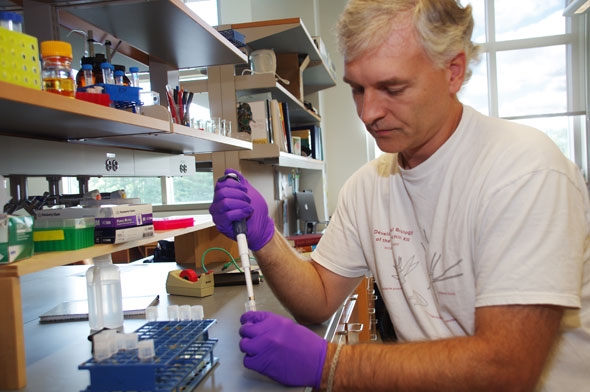Two years after graduating premed from Montana’s Carroll College, Kevin Peterson remembered his childhood fossil collection.
“I was sitting in my living room thinking, ‘I’m maxima cum laude, working nights at UPS, my dad is on my case, I have no life’ and I knew I didn’t want to go to medical school. Then I remembered this fossil collection I had as a kid,” recalls Peterson, now an associate professor of biological sciences and an adjunct professor of earth sciences at Dartmouth.

Professor Kevin Peterson, who solves evolutionary mysteries molecularly, prepares samples for micro RNA analysis. (photo by Joseph Blumberg)
Though his interests were driven at the outset by the remains of animals preserved in stone, the breadth of his work has expanded beyond those confines. He calls his work molecular paleobiology and, as the name implies, Peterson uses the molecular and genetic complement of creatures inhabiting the world today to reconstruct their prehistory and interrelationships over deep time. Consistent with this, his Dartmouth duties now also comprehend associate professorships in the graduate programs in molecular and cellular biology, and ecology and evolutionary biology.
Concentrating on micro RNAs (miRNAs)—short regulatory molecules found in cells—Peterson’s work has attracted significant attention in the scientific community. Peterson tells us that once a miRNA appears in an animal’s ancestral lineage, it is rarely lost. Rather, these molecules tend to accumulate over time. This makes miRNAs an important tool in discerning relationships and solving evolutionary puzzles.
In fact, miRNAs have helped Peterson solve the mystery of the turtle’s evolutionary history as well as determining how groups of marine organisms are related to one another. He has shown how miRNAs can also document the direction evolution may have taken, as mileposts on the path from the simple to the complex or even the reverse.

Paleontological inspiration first came to Peterson through Stephen Jay Gould’s national bestseller, Wonderful Life: The Burgess Shale and the Nature of History (1989), shortly after it was published. The book chronicles one of the most dramatic stages in the evolution of life—the Cambrian explosion. About 540 million years ago, most of the major groups of animals appeared in what Peterson calls “a geological blink of an eye.” A host of trilobites, crustaceans, and other hard-bodied creatures in a vast array of shapes and sizes took over the oceans.
But inspiration was not enough. The premed graduate, highly motivated but untrained in paleontology, applied to graduate programs without success. Peterson lacked a background in geology, evolutionary biology and other prerequisite disciplines.
On the plus side, Peterson had a history of research experience. He had spent undergraduate summers in a New Jersey medical school laboratory studying mouse developmental genetics. “My exposure to research at this stage was pivotal, as it allowed me to relax about not knowing very much, and about feeling okay asking silly questions,” he recalls.
Finally, he was accepted into the geology department and the Center for the Study of Evolution and the Origin of Life at UCLA. The program opened the door to his thinking about evolution from the perspective of a developmental biologist, almost an embryologist, Peterson reflects. “Embryology was my strength as an undergraduate,” he notes. “If you look at Wonderful Life, you see all these weird and wonderful creatures, all built differently—a problem that could be approached from a developmental standpoint.”
Peterson’s graduate and postdoctoral advisers were experts in developmental and evolutionary biology and they encouraged him to try and address typical paleontological questions from a molecular perspective.
But Peterson has not abandoned his beloved fossils for the magic of molecules. In a field marked by contention, he has sought to unite opposing camps.
“The history of life is written in two records—the geologic and the genetic—and no one record is primary. They show different things,” Peterson tells us. “We use one to test the other and vice versa. They each have their strengths and their weaknesses. You cannot do Earth history and the history of life while ignoring half of the record.”
Peterson’s research is supported by the National Science Foundation and a NASA National Astrobiology Institute grant.
